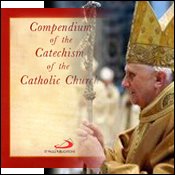This fall marks the release of the long-awaited Compendium of the Catechism of the Catholic Church, providing us an opportunity to take stock of the state of catechesis in the Church in America and to examine the potential of this new teaching tool.
As its name suggests, the Compendium is based on the longer Catechism of the Catholic Church. Sales of the Catechism (CCC), first released in 1992, have been impressive, with at least 8 million sold worldwide. Catechetical elites wrongly claimed that the Catechism was exclusively for bishops, priests, and other professionals. But there simply aren’t enough of these professionals to account for the number of books sold. Interested lay Catholics couldn’t gobble up copies fast enough.
However, if the purpose of the CCC was to bring about a revolution of orthodox religious instruction after two decades of the post-Vatican II “silly season,” it fell a bit short of the mark. Not only was it resisted by the very people who were supposed to have embraced it, i.e., parish instructors, but its 700-page heft proved intimidating to many members of the laity.
Where it succeeded was in providing orthodox Catholics with a yardstick against which to measure the public statements of those charged with teaching the Faith in their parishes. Prior to the Catechism’s release, their options were limited. They could cite an “unofficial” local catechism, but that could be dismissed as merely someone else’s opinion. Alternately, they could hunt and peck through the decrees of Vatican II, but until recently those documents were not widely available. With the release of the official Catechism, the faithful now had a comprehensive, Magisterium-issued guide. In one book, Catholics could find an authoritative explanation of the Creed, Scripture, the Commandments, and the Mass and Sacraments. Pope John Paul II called it “a sure norm for teaching the Faith.”
Publishers caught on too. The USCCB’s committee on catechesis recently found that two-thirds of the religion textbooks targeting Catholic high school students were so out of conformity with the Catechism that they had to be scrapped entirely. Those that made the cut proudly displayed their conformity as a Catholic “Good Housekeeping” seal of approval. Similarly, pre-publication local catechisms revised their texts to reflect the teachings and emphasis of the CCC. A new wave of books and guides summarizing the document and explaining it to the laity grew in popularity.
Publishers caught on too. The USCCB’s committee on catechesis recently found that two-thirds of the religion textbooks targeting Catholic high school students were so out of conformity with the Catechism that they had to be scrapped entirely. Those that made the cut proudly displayed their conformity as a Catholic “Good Housekeeping” seal of approval. Similarly, pre-publication local catechisms revised their texts to reflect the teachings and emphasis of the CCC. A new wave of books and guides summarizing the document and explaining it to the laity grew in popularity.
And this is where the Compendium comes in. At a mere 200 small pages capturing 598 questions and answers, it parallels and abbreviates the longer CCC. Although some experts may roll their eyes at the re-introduction of an official teaching document using such a format, Q&A columns frequently are the most popular features of secular and religious newspapers and magazines. Likewise, FAQ documents are used in everything from product descriptions to science textbooks to sales training manuals. So it is a format which the laity likely will find very familiar.
A few years ago, when a friend suggested the use of a Q&A catechetical text to lead a course of instruction at his parish, he was told that the Church now frowns on “memorization.” Yet here is Pope Benedict XVI in his introduction to the Compendium: “The dialogical format also lends itself to brevity in the text, by reducing it to what is essential. This may help the reader to grasp the contents and possibly to memorize them as well.”
Lay Catholics should consider conducting a personal apostolate to greet the Compendium. First, buy yourself a copy and read it, perhaps even memorizing key passages. Second, buy an extra copy for your parish priest or church library. Next, distribute copies as Christmas gifts for friends and family members. Lastly, offer to lead or coordinate a Compendium discussion group, either at your parish or in your home.
Let us work to make it so.
.
- © Copyright 2005 Catholic Exchange


No comments:
Post a Comment